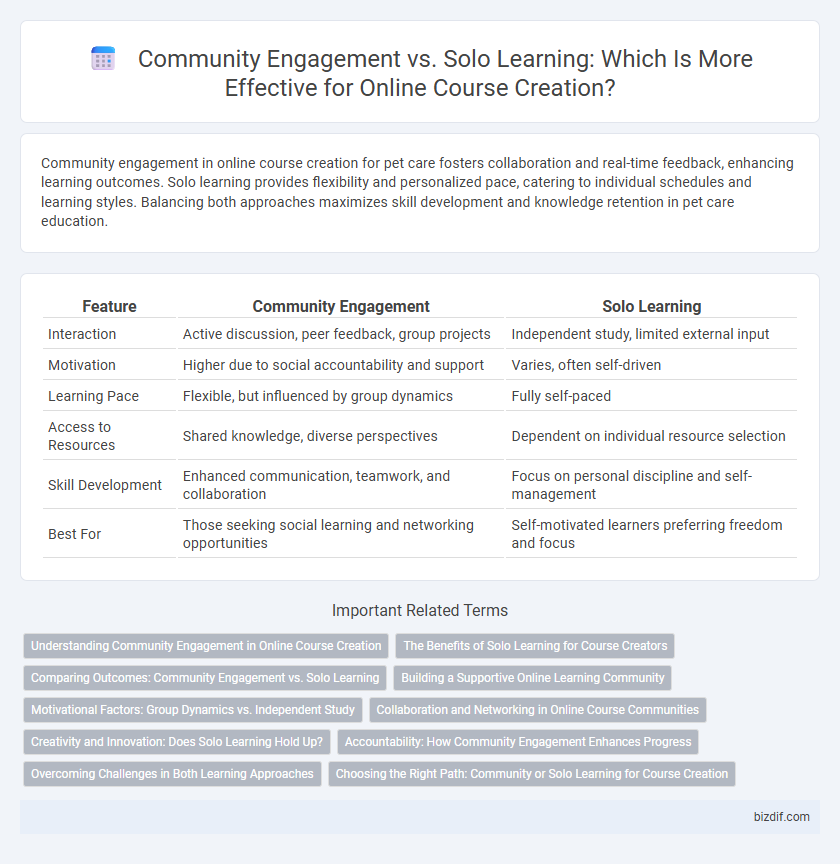Community engagement in online course creation for pet care fosters collaboration and real-time feedback, enhancing learning outcomes. Solo learning provides flexibility and personalized pace, catering to individual schedules and learning styles. Balancing both approaches maximizes skill development and knowledge retention in pet care education.
Table of Comparison
| Feature | Community Engagement | Solo Learning |
|---|---|---|
| Interaction | Active discussion, peer feedback, group projects | Independent study, limited external input |
| Motivation | Higher due to social accountability and support | Varies, often self-driven |
| Learning Pace | Flexible, but influenced by group dynamics | Fully self-paced |
| Access to Resources | Shared knowledge, diverse perspectives | Dependent on individual resource selection |
| Skill Development | Enhanced communication, teamwork, and collaboration | Focus on personal discipline and self-management |
| Best For | Those seeking social learning and networking opportunities | Self-motivated learners preferring freedom and focus |
Understanding Community Engagement in Online Course Creation
Understanding community engagement in online course creation enhances learner motivation and retention by fostering collaboration and peer support. Active communities promote knowledge sharing, real-time feedback, and diverse perspectives, which contribute to deeper comprehension and practical application of course material. Integrating forums, live Q&A sessions, and group projects transforms solitary learning into an interactive, dynamic experience that boosts overall course effectiveness.
The Benefits of Solo Learning for Course Creators
Solo learning empowers course creators to tailor their content development process with full creative control and flexibility, allowing for a personalized and adaptive approach. It enhances deep focus and self-paced progress, reducing distractions and enabling mastery of course material. This method also fosters independence and self-discipline, essential traits for innovative and effective online course design.
Comparing Outcomes: Community Engagement vs. Solo Learning
Community engagement in online course creation fosters higher retention rates and deeper knowledge assimilation compared to solo learning, driven by peer interaction and collaborative problem-solving. Solo learning offers flexibility and personalized pacing but often lacks the motivational support and diverse perspectives present in community settings. Data from e-learning platforms indicate courses with active community forums see up to 30% higher completion rates than self-paced, isolated study models.
Building a Supportive Online Learning Community
Building a supportive online learning community enhances engagement by fostering collaboration, peer feedback, and motivation, which solo learning often lacks. Active participation through discussion forums, group projects, and live Q&A sessions cultivates a sense of belonging and accountability among learners. This collaborative environment not only improves knowledge retention but also drives course completion rates, making community engagement a critical factor in successful online course creation.
Motivational Factors: Group Dynamics vs. Independent Study
Community engagement in online course creation boosts motivation through group dynamics, fostering accountability and collaborative learning that enhances retention and understanding. Solo learning relies on intrinsic motivation, allowing learners to set personalized goals and pace, which suits self-disciplined individuals seeking flexibility. Both approaches impact learner motivation differently, with community-based courses leveraging social interaction and solo courses emphasizing autonomy and self-regulation.
Collaboration and Networking in Online Course Communities
Online course communities foster collaboration and networking, enhancing learner engagement beyond solo study. Active participation in discussion forums and group projects accelerates knowledge exchange and skill development. Networking within these communities builds professional connections that support continuous learning and career growth.
Creativity and Innovation: Does Solo Learning Hold Up?
Community engagement in online course creation fosters creativity and innovation by enabling diverse perspectives and collaborative problem-solving, which often leads to more dynamic and original ideas. Solo learning can develop individual creativity through deep focus and self-paced exploration, but it generally lacks the interactive feedback and varied insights that spark breakthrough innovations found in group settings. Research indicates that while solo learners may excel in foundational skill-building, community-driven environments better facilitate creative thinking and innovative outcomes.
Accountability: How Community Engagement Enhances Progress
Community engagement in online course creation significantly boosts accountability by fostering peer support and shared goals, which drives consistent progress. Participants in collaborative learning environments tend to complete courses more efficiently due to regular interaction and mutual encouragement. Solo learners often face challenges in maintaining motivation without external accountability mechanisms inherent in community settings.
Overcoming Challenges in Both Learning Approaches
Community engagement in online course creation fosters collaboration and diverse perspectives, which can alleviate individual challenges such as motivation and problem-solving. Solo learning demands self-discipline and personalized strategies to overcome obstacles like time management and knowledge gaps. Effective online education platforms integrate tools for peer interaction and support, enhancing success rates in both learning approaches.
Choosing the Right Path: Community or Solo Learning for Course Creation
Community engagement in online course creation fosters collaboration, real-time feedback, and diverse perspectives, enhancing content quality and learner motivation. Solo learning offers flexibility, personalized pacing, and deep focus essential for creators who prefer independent development without external distractions. Selecting between community involvement and solo creation depends on the course goals, preferred learning style, and desired interaction level to maximize course effectiveness and instructor satisfaction.
Community engagement vs Solo learning Infographic

 bizdif.com
bizdif.com